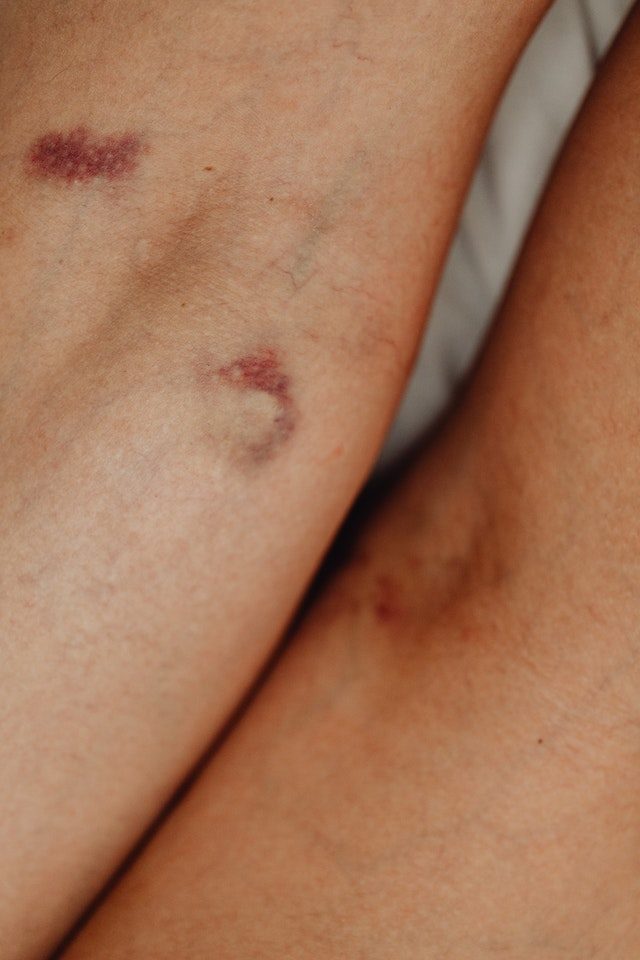
What are bruises? They are where blood vessels near the skin’s surface are broken after an impact.
There are three layers in the skin: the epidermis, dermis, and hypodermis. The outer layer of our skin, the epidermis, doesn’t have any blood vessels. All of the blood vessels are in the dermis. New skin cells grow at the bottom of the epidermis, next to the dermis, where they have a supply of nutrients and oxygen from the blood. Once they have formed, they move upwards until they become the outer layer of the epidermis. They die as they go and no longer need a blood supply. As each layer of dead skin cells comes off, a new layer grows up to replace them. The blood supply is in the dermis. That’s why a scratch or a light scrape doesn’t usually bleed. A graze might bleed in spots because it is slightly deeper in some places than in others.
The blood vessels in the dermis are called capillaries because they are tiny. Capillaries have thin walls because their job is to let oxygen and nutrients pass out of them into the tissue they thread through. They also remove waste products and carbon dioxide from the tissue. They connect the arteries, which carry oxygenated blood from the heart, and veins, which carry oxygen-poor blood back to the heart. Because they have to be very thin, the capillaries are very delicate.
Bruises are technically called ecchymosis. It comes from the Greek word “ekkhumōsis”, which means “escape of blood”. A bruise happens when your tissue suffers an impact that is forceful enough to break these capillaries in the dermis. The impact is strong enough to rupture the blood vessels, but it is not strong or sharp enough to break the skin, so the blood stays inside the body. Blood comes out of the capillary and pools beneath the skin. Depending on how broken the capillary is, the body will either fix it, or shut it off and make a new one. Either way, in most cases, the blood pooling into the body will stop fairly quickly. It quite often will take on some of the shape of the thing that impacted the person because that is where the capillaries are broken. For example, if someone hits their thigh hard on the edge of a kitchen table, the capillaries will be broken at that point. The blood will seep past the broken capillaries into the surrounding flesh, but it will be greatest at the point where they broke, resembling the shape of the edge of the kitchen table.
At first, the bruise is red because the blood pooled under the skin is red. The blood seeps into the tissue and keeps spreading until the body stops the blood supply or fixes the capillary. The blood in the tissue makes it swell and the nerves in the skin detect the extra pressure, sending pain signals to the brain.
After a short time, the oxygen in the blood is reabsorbed into the tissue and the blood under the bruise changes color to shades of blue, purple, or even black. After five to ten days, the bruise will turn yellow or green. This is because the body is breaking down the hemoglobin in the blood. The body produces bilirubin and biliverdin when it breaks down the red blood cells. These are both found in bile. “Bilirubin” means “red bile” in Latin, and “biliverdin” means “green bile”. They are both used to break down old or mutated red blood cells and their coloration is what gives the bruise its colors. There is a protein in the blood called heme that is used to bind oxygen. When the body breaks heme down, it is first converted to biliverdin, which is green, then that is converted to bilirubin, which is actually yellowish. After ten to fourteen days, the blood will all have been broken down and the bruise will turn light brown before it disappears completely.
Some people bruise more easily than others because they have more fragile capillaries. Usually, women and young children bruise more easily than men. Sunbathing a lot can also make it more likely that you will bruise because the sun slowly weakens the skin and the blood vessels. Easy bruising can also be a sign of liver damage. People that drink a lot and have cirrhosis of the liver will bruise more easily. This is because cirrhosis causes the liver to reduce the production of the proteins that are needed for blood clotting. If the blood can’t clot properly, it makes bruising far more likely. And this is what I learned today.
Photo by Karolina Grabowska: https://www.pexels.com/photo/close-up-of-person-skin-with-bruises-6643066/
Sources
https://www.ncbi.nlm.nih.gov/books/NBK470464/
https://my.clevelandclinic.org/health/body/21901-epidermis
https://my.clevelandclinic.org/health/body/21640-blood-vessels
https://www.medicalnewstoday.com/articles/322742#when-to-worry-about-bruises
https://en.wikipedia.org/wiki/Bilirubin
https://en.wikipedia.org/wiki/Biliverdin
https://www.webmd.com/skin-problems-and-treatments/why-do-i-bruise-so-easily
https://www.verywellhealth.com/complications-of-cirrhosis-63380
https://www.medicalnewstoday.com/articles/322829#symptoms
https://www.webmd.com/first-aid/causes-bruises
https://en.wikipedia.org/wiki/Bruise
https://www.osmosis.org/answers/ecchymosis
https://my.clevelandclinic.org/health/diseases/15235-bruises
